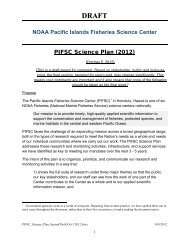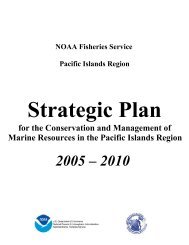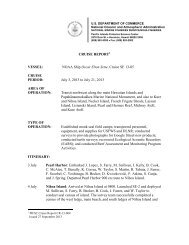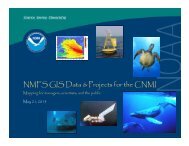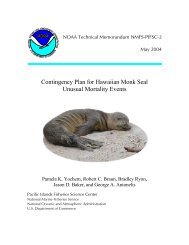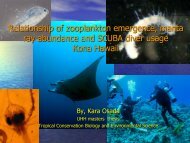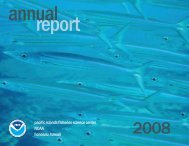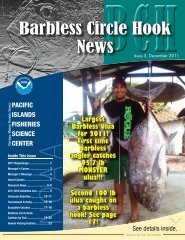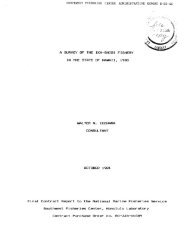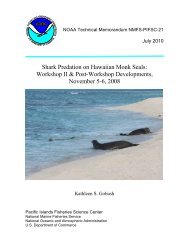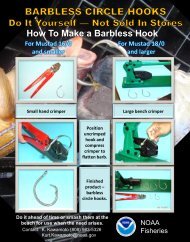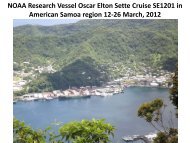NATIONAL MARINE FISHERIES SERVICE - Pacific Islands ...
NATIONAL MARINE FISHERIES SERVICE - Pacific Islands ...
NATIONAL MARINE FISHERIES SERVICE - Pacific Islands ...
Create successful ePaper yourself
Turn your PDF publications into a flip-book with our unique Google optimized e-Paper software.
Southwest Fisheries Center Administrative Report H-83-9<br />
U.8. DEPARTMENT OF COMMERCE<br />
National Oceanic and Atmomphmriu Adminhtntion<br />
<strong>NATIONAL</strong> <strong>MARINE</strong> <strong>FISHERIES</strong> <strong>SERVICE</strong><br />
Southwest Fisheries Center<br />
Honolulu Laboratory<br />
P. 0. Box 3830<br />
Honolulu, Hawaii 96812<br />
A SUMMARY OF THE 1983 TUNA BAITFISH WORKSHOP<br />
Richard S. Shomura<br />
Southwest Fisheries Center Honolulu Laboratory<br />
National Marine Fisheries Service, NOAA<br />
Honol ul u , Hawai i 96812<br />
and<br />
Henry M. Sakuda<br />
Division of Aquatic Resources<br />
Department of Land and Natural Resources<br />
Honol ul u , Hawai i 96813<br />
June 1983
An informal tuna baitfish workshop, cosponsored by the Honolulu Laboratory,<br />
Southwest Fisheries Center, National Marine Fisheries Service (NME'S) and the<br />
Hawaii Division of Aquatic Resources (DAR), was held at the NMFS Kewalo Research<br />
Facility on April 14, 1983. Eight informal papers presented at the workshop<br />
addressed past and present trends and the status of the baitfish fishery, substitute<br />
bait, habitat enhancement, and economic considerations. The 71 persons<br />
attending the workshop included leaders of the tuna industry, boat owners, boat<br />
captains, interested fishermen, and scientists from NMFS, DAR, Naval Ocean<br />
Systems Center (NOSC), and the University of Hawaii's Institute of Marine Biology<br />
(HIMB)<br />
The purposes of the workshop were to review the problem of bait shortage in<br />
the Hawaiian skipjack tuna fishery and identify possible solutions. The workshop<br />
was organized into six sections, as noted below.<br />
The informal nature of the workshop encouraged discussion and a free<br />
exchange of ideas among the participants, who all had a common interest (1) in<br />
finding short-term solutions to the current critical bait shortages, particularly<br />
in time for the I983 summer fishing season, and (2) to identify long-term goals<br />
and objectives to assure sustained bait production for the future well-being of<br />
the aku fishery.<br />
1. Present status of the aku fishery<br />
From a review of the status of the aku fishery, it was apparent that aku<br />
production declined sharply in mid-1982. The I982 total catch was only 6,600 lb<br />
above that of 1980, the poorest year on record.<br />
The very low catches for 1980-81 prompted appeals from the industry for<br />
assistance and relief from the problems of bait shortage and mortality that<br />
almost constantly plague the fishermen. Discussed were research projects such<br />
as nehu habitat enhancement that could provide quick relief.<br />
The review also brought out that aku production steadily declined from<br />
9.2 million lb in 1971 to 2.4 million lb in 1980. Catch/boat showed a similar<br />
downward trend. It was noted that during this period of declining catches,<br />
Federal, State, and academic researchers had not taken an active part in trying<br />
to solve some of the problems, particularly as they relate to bait mortality and<br />
shortages. Criticisms and past feelings aside, it was brought out that the<br />
industry and the scientific community must come together to seek possible shortterm<br />
and long-term solutions to keep the industry viable.<br />
Discussion then focused on the current Aku Catch Report form, which even<br />
when filled out properly according to instructions, left much to be desired.<br />
Modification of the presently used form was strongly recommended.<br />
The occurrence of "red mud" (red tide) in Pearl Harbor has also been a<br />
long-time concern of the fishermen. DAR identified this phenomenon as a dinoflagellate<br />
bloom. Apparently, water from "red mud" areas pumped into aku boat<br />
baitwells has caused total mortality of nehu. A baitwell aeration device,<br />
developed through the cooperative efforts of boat captains and DAR biologists,<br />
has apparently proved helpful.
2<br />
G<br />
It was pointed out that catching bait in Pearl Harbor's West Loch is no<br />
longer practical because almost no bait is available in this sector. The question<br />
asked was whether this condition is merely temporary or more or less permanent.<br />
On other species, it was questioned whether substitute cultured bait could<br />
be made available in time for the upcoming aku season and whether the species<br />
being considered for culture would be acceptable to the fishermen.<br />
Other questions raised during the review addressed the problem of whether<br />
nehu habitat could be enhanced, and whether si-gnificant declines in nehu abundance<br />
could be reversed.<br />
All the boat captains agreed that nehu aggregated near recently dredged<br />
areas. Preliminary tests conducted in the past indicated that bottom sediment<br />
agitation or disturbance served as a concentrating mechanism for nehu. Some<br />
workshop participants felt the concept had merit and strongly supported it<br />
as a means of providing quick relief for the aku boats. Furthermore, it was<br />
highly recommended that research should continue in finding a viable substitute<br />
bait and that research be initiated in enhancing nehu habitat.<br />
2. Review of the nehu fisherv<br />
Discussion centered on statewide historical catches, baiting effort, and<br />
catch per effort of baitfish in 1960-81. It was noted that significant changes<br />
had occurred in bait catching practices over the 22-year period examin.ed. The<br />
10-year period from 1960-69 was one of rather low ca-tches and fishing pressure<br />
compared with the 10-year period from 1970-79. Whereas the total catch in<br />
1360-69 averaged 32,300 buckets, the 1970-79 catches averaged 21% higher or<br />
roughly 39,200 buckets.<br />
26,500 bucktes.<br />
In 1980-81, the average annual catch declined to only<br />
The review also brought out that the practice of catching bait at night<br />
has declined steadily since 1965, and in recent years practically none of the<br />
vessels were engaged in thistype ofactivity. As a consequence, day-bait<br />
catching effort has increased significantly.<br />
Over the years examined, Pearl Harbor and Kaneohe Bay were, by far, the<br />
most important bait grounds, contributing 336 and 37%, respectively, to the<br />
statewide bait catches. The remaining catches were contributed by a number<br />
of other areas of minor importance such as Ala Wai Canal, Haleiwa, and the<br />
neighbor island sites .<br />
Pearl Harbor showed rather wide fluctuations in bait catch and effort<br />
over the years 1960-81 but catch/effort has remained relatively constant<br />
with no noticeable trends. However, rather dramatic changes have occurred<br />
over the years in Kaneohe Bay. Total bait catch and effort rose significantly<br />
in I966 and again in 1973. Also, whereas effort increased 96% from 1972 to<br />
1977 in Kaneohe Bay, catch rose only 60% during the same period. After 1973,<br />
when catch/effort peaked in Kaneohe Bay, the index of relative abundance<br />
declined steadily. It was determined that the fishery is probably not the cause<br />
of the decline but that a decline in food supply may be responsible.
3<br />
The review also dealt with nehu mortality, pointing out that before 1967,<br />
baitfish mortality fluctuated between 12% and 21%. In 1967-81, the mortality<br />
fluctuated between 2@/0 and 3@/0. Mortality is usually lower during the summer<br />
and the reasons cited were that bait is used faster in summer and that summer<br />
bait may be stronger.<br />
Nehu spawn all year long and spawning peaks in summer although this peak<br />
may shift to late winter and early spring. Nehu eggs are planktonic, and<br />
incubation isabout24 hours. Growth of larvae after hatching is rapid and<br />
metamorphosis to the adult stage occurs in 6-7 weeks. From time of hatching,<br />
8 to 12 weeks are required before nehu are sexually mature at approximately<br />
30 mm standard length. Very few nehu live longer than one year.<br />
It was pointed out that there has been a gradual increase in the catch of<br />
"sardine" which reached 1P/O in 1977 and nearly 21% by 1981. The species is<br />
actually a herring common to waters of the Marshall <strong>Islands</strong> and not the Marquesan<br />
sardine that was originally introduced from the Marquesas <strong>Islands</strong> in the late<br />
1950s.<br />
The ensuing discussion indicated that the fishermen strongly believe that<br />
introductions of talapia and sardine were responsible for the decline in the<br />
nehu population. Some fishermen stated that these species fed extensively on<br />
larval, juvenile, and adult nehu. Pollution of the habitat resulting from<br />
discharge of wash water from fertilizer barges was also cited as a cause for<br />
decline in nehu abundance.<br />
3. Review of alternative species<br />
a. Mollies (Maui Project) .--The Maui mollie culture facility at Kealia<br />
started production in 1978 to determine the feasibility of culturing a supplemental<br />
baitfish. Based on past results of HIMB experiments and sea tests<br />
conducted in American Samoa, the project concentrated on the Mexican topminnow,<br />
which exhibited most of the characteristics of a good baitfish. The facility<br />
uses brood ponds, fry collecting troughs, and rearing ponds. It was reported<br />
that mollies could be reared to bait size in three months. To enhance<br />
production, solar domes to raise temperatures and a waste recycling system<br />
was instituted, the latter based on the concept of fertilizing water with<br />
duck manure. The ponds were also stocked with silver and grass carps and<br />
mullet.<br />
Comparison of aku catch rates using mollies and nehu demonstrated that<br />
differences were relatively small, particularly when fishing schools around<br />
fish aggregating devices. For open-sea school fishing, the aku boat ORION<br />
caught 15.28 lb of aku/lb of mollies. It was pointed out that fishing<br />
methods, particularly chumming to hold the school near the stern, have to be<br />
modified when fishing with mollies.<br />
It was brought out that about 2,000 lb of mollies were being reared for<br />
delivery to an albacore boat for testing this summer in the Hawaiian <strong>Islands</strong>.<br />
Near-term goals were to culture as much as 3,000-4,000 lb for aku fishing and<br />
that plans are underway for construction of a large-scale facility.
4<br />
b. Culture experiments in the South <strong>Pacific</strong>.--Mollies and milkfish have<br />
been the species of primary interest of some South <strong>Pacific</strong> island governments<br />
in the culture and use of bait in tuna fishing. Results from trials conducted<br />
in American Samoa, Palau, Tonga, French Polynesia, Kiribati, Cook Island, and<br />
Pitcairn Island were reviewed. At several locations, trials with mollies and<br />
talapia were discontinued due to lack of interest and lack of funds. Among<br />
the more encouraging results were those the South <strong>Pacific</strong> Commission (SPC) in<br />
French Polynesia where the HATSUTORI MU, a vessel chartered for aku tagging,<br />
obtained a catch rate of 34.7 lb/unit of bait (UOB) using milkfish as bait.<br />
At Kiribati, the following aku catches were obtained: 38.5 lb/UOB with mollies<br />
and 55.9 lb/UOB with milkfish. In comparison, for the period 1950-72 nehu<br />
yielded a catch of 16-37 lb/UOB in Hawaii. Thus, on this basis, nehu could be<br />
termed a poor baitfish by the SPC researchers. It was also reported that many<br />
of these trials were based on small amounts of bait; however, it appears to be<br />
rather clear that milkfish is a much better baitfish than mollies.<br />
c. Tilapia and threadfin shad.--A pilot tilapia culture plant, established<br />
in Paia, Maui, produced roughly 450 buckets of baitfish in each of the two years<br />
that the plant was in operation (1958-59).<br />
Test fishing with bait produced at this plant yielded an average of 53 lb<br />
of aku/lb of tilapia as compared with 64 lb of aku/lb of nehu. Fishing was<br />
conducted using each bait species alternately on schools encountered. For<br />
wild schools and schools of large aku, tilapia proved to be relatively effective.<br />
Results from this pilot study led eventually to the establishment of the<br />
State's tilipia culture station at Sand Island in 1960. This facility produced<br />
about 3,000 lb of baitsize tilapia per year; maximum production was 5,000 lb<br />
per year.<br />
Field trials with threadfin shad on the R/V CHARLES H. GILBERT produced<br />
good results. Shad, a freshwater species found mainly in Wahiawa Reservoir<br />
on Oahu, is not easily obtained, and the capture, transport, and acclimation<br />
procedure could be expensive as well as labor-intensive. It has been estimated<br />
that from 5,000 to 10,000 buckets of shad inhabit the reservoir and that shad<br />
abundance is probably related to water level in the reservoir.<br />
d. Mullet and milkfish culture.--Research on mullet at Oceanic Institute<br />
began in 1969 but it wasn't until 1980-82 that mass production research, funded<br />
by <strong>Pacific</strong> Tuna Development Foundation (PTDF) and the State, got underway.<br />
Mullet attain sexual maturity in three years and experimental results indicate<br />
that an average fertilization rate of 9@/0 and an average hatching rate of 7@/0<br />
are expected. About 600,000 viable eggs can be obtained from an adult female.<br />
The hatched larvae are fed cultured rotifers, which in turn were fed<br />
cultured phytoplankton. Larval survival ranged from zero to 50"/0. About 45<br />
days are required for the larvae to reach the fry stage.<br />
Current plans call for shifting from tank to pond culture which should<br />
cut down the production cost.<br />
Research on milkfish is still ongoing at Oceanic Institute.
4. Habitat enhancement<br />
5<br />
From a review presented earlier and based on discussions that ensued, it<br />
was apparent that immediate relief was necessary to help the industry. Discussion<br />
led to agreement among the boat captains that habitat enhancement looked<br />
like an attractive near-term solution and that a project to stir up the bottom<br />
sediment at selected localities should be strongly recommended. Because of<br />
possible environmental and legal constraints in pursuing such a project, it<br />
was recommended that the US Corps of-Engineers be consulted or invited to<br />
attend the Hawaii Fishery Coordinating Council (HFCC) meeting where short- and<br />
long-term solutions to the bait problem were to be recommended and discussed.<br />
The Workshop was opened to comments from two investigators who reported<br />
on (1) water quality studies conducted at Pearl Harbor and on (2) nehu population<br />
studies in Kaneohe Bay. Sediment metabolism studies currently underway at three<br />
primary locales in Pearl Harbor will examine the effect of sewage diversion on<br />
the total ecosystem. It was indicated that although sewage diversion will<br />
reduce nitrogen and phosphorus in the ecosystem, the nutrients available to<br />
phytoplankton will not be cut off overnight or completely. Much nitrogen and<br />
phosphorus will still enter Pearl Harbor through streams that empty into the<br />
harbor. Nutrients are also expected to leach at high rates from accumulated<br />
bottom muds for at least several months.<br />
It was noted that red tide blooms have increased significantly since<br />
Hurricane IWA, possibly in response to "Kana" winds which decrease circulation<br />
in the harbor and cause nutrient concentrations to increase.<br />
Presently the US Navy conducts only routine environmental monitoring<br />
required by the Environmental Protection Agency (EPA). There is no intensive<br />
monitoring of overall environmental conditions going on at this time.<br />
Pearl Harbor was described as heavily stressed and no living corals can<br />
be found in the harbor probably because of the high concentrations of heavy<br />
metals. Nehu, however, show no apparent direct effect from heavy metal pollution.<br />
It is likely, however, that heavy metals and other pollutants may affect<br />
planktonic organisms constituting the nehu's diet.<br />
A study of the nehu population in Kaneohe Bay has produced results which<br />
indicated that the adults and large larvae migrate into shallow water to seek<br />
shelter along the coast during the day and move into deep waters of the bay at<br />
night. Eggs and newly hatched larvae are found primarily in deep water.<br />
5. Economic considerations<br />
In discussing economic considerations, it was noted that demand and price<br />
were the two most important considerations. The topminnow was cited a.s an<br />
example of a good cultured bait that can be produced rather cheaply. Based<br />
on I980 data, it was estimated that initial start-up costs could reach $23,000/<br />
acre of pond and annual operating costs would be about $16,00o/acre. The cost<br />
of producing topminnow was estimated to be abut $l.60/lb ( 10,000 lb/acre<br />
production) and $2.70 lb (6,000 lb/acre production). The current cost of<br />
production is estimated at aht $3.00/lb with production of 8,500 lb/acre.<br />
The question is whether there is a demand for topminnow at this price.
6<br />
It was added that in 1980, Japanese pole-and-line fishing boats paid<br />
$1.7O-I,80/1b for natural bait. Based on the ratio of tuna price and cost of<br />
bait, it was estimated that if topminnow cost $3.00/l-b, then the price of tuna<br />
should be $l.O4/lb or $2,31O/ton.<br />
6. Recommendations<br />
The participants developed recommendations for presentation to the HFCC.<br />
These recommendations were categorized into those that needed immediate attention<br />
or short-term solutions and those requiring more detailed long-term research.<br />
Among the short-term recommendations were:<br />
1. Enhance the natural habitat of nehu by stirring up or agitating bottom<br />
sediment. It was noted that this project, which was considered top priority,<br />
would provide quick relief by attracting nehu from surrounding areas; however,<br />
there is danger that this action may further reduce the already low abundance<br />
of the existing nehu stock.<br />
2. Seek access to grounds where nehu are known to congregate but which<br />
are off-limits due to private or government-imposed restrictions.<br />
3. Identify all facilities that could be put into immediate operation for<br />
culturing either tilapia or mollies. The consensus among the boat captains,<br />
however, was that mollies were preferred over tilapia.<br />
4. Examine impact of and possibly remove restrictions, if any, on sale<br />
of tilapia and "sardine" so that the boats may be able to sell these species<br />
when they are captured in the bait seines.<br />
5. Modify the presently existing Aku Catch Report form so that more<br />
meaningful catch and effort statistics could be collected not only for<br />
scientific analysis but also so that more feedback can be provided to industry.<br />
Long-term recornendations included:<br />
1. Compile and analyze available information and conduct a full investigation<br />
on the ecosystem in Pearl Harbor and Kaneohe Bay to determine how<br />
natural phenomena and man-induced activities influence or affect the nehu<br />
populations.<br />
2. Encourage continued research on milkfish culture so that the species<br />
could be eventually produced on a large scale as baitfish.
7<br />
APPENDIX 1<br />
AGENDA<br />
Opening statement (Richard Shomura/Henry Sakuda)<br />
Objectives of workshop<br />
1. Present status of the aku fishery (John Robey)<br />
2. Review of the nehu fishery (Richard Uchida)<br />
3. Review of alternative species<br />
a. Mollies (Maui project) (Fred Matsumoto)<br />
b. Culture experiments in the South <strong>Pacific</strong> (Wayne Baldwin)<br />
c. Tilapia and threadfin shad (Thomas Hida)<br />
d. Mullet and milkfish culture (Cheng Sheng Lee)<br />
4. Habitat enhancement (Henry Okamoto)<br />
5. Economic considerations (Yung C. Shang)<br />
6. Recommendations (open discussion)<br />
Short- term<br />
Long- term
8<br />
APPrnIX 2<br />
LIST OF PARTICIPANTS<br />
Louis Agard<br />
1089-A Ala Moana Blvd.<br />
Honolulu, Hawaii 96814<br />
Bob Agres<br />
Economic Department<br />
Maui County<br />
200 South High Street<br />
Wailuku, Maui, Hawaii 96793<br />
Walter Asari<br />
Owner/Captain<br />
F/V MARLIN<br />
c/o P. 0. Box 238<br />
Honolulu, Hawaii 96809<br />
Wayne Baldwin<br />
Hawaii Institute of Marine Biology<br />
University of Hawaii<br />
P. 0. Box 1346<br />
Kaneohe, Hawaii 96744<br />
Ed Bartholomew<br />
Sea Grant Extension Svc.<br />
Maui Community College, Bldg. 214<br />
310 Kaahwnanu Avenue<br />
Kahului, Maui, Hawaii 96732<br />
Paul Bartram<br />
1 I45 21 st Avenue<br />
Honolulu, Hawaii 96816<br />
Dr. Richard Brill<br />
NMFS, Honolulu Laboratory<br />
P. 0. Box 3830<br />
Honolulu, Hawaii 9681 2<br />
Dr. Richard Brock<br />
Hawaii Institute of Marine Biology<br />
University of Hawaii<br />
P. 0. Box 1346<br />
Kaneohe, Hawaii 96744<br />
Allen Cattell<br />
AECOS, Inc.<br />
970 N. Kalaheo Avenue<br />
Suite A-300<br />
Kailua, Hawaii 96734<br />
Randy Chang<br />
NMFS, Honolulu Laboratory<br />
P. 0. Box 3830<br />
Honolulu, Hawaii 96812<br />
Bill Choy<br />
1605 Piihana Street<br />
Wailuku, Maui, Hawaii 96793<br />
Dr. Tom Clarke<br />
Hawaii Institute of Marine Biology<br />
University of Hawaii<br />
P. 0. Box 1346<br />
Kaneohe, Hawaii 96744<br />
Alika Cooper<br />
163 Kaiulani Street<br />
Hilo, Hawaii 96720<br />
John Corbin<br />
Aquaculture Development Program<br />
Department of Land & Natural Resources<br />
335 Merchant Street<br />
Honolulu, Hawaii 96813<br />
David Crear<br />
AECOS, Inc.<br />
970 N. Kalaheo Avenue<br />
Suite A-300<br />
Kailua, Hawaii 96734<br />
Frank Goto<br />
Manager, United Fishing Agency<br />
117 Ahui Street<br />
Honolulu, Hawaii 96813<br />
Albert Grace<br />
Captain<br />
F/V TRADEWIND<br />
c/o P. 0. Box 238<br />
Honolulu, Hawaii 96809<br />
Charles Greenwald<br />
Aquatic Farms<br />
49-139 Kamehameha Highway<br />
Kaneohe, Hawaii 96744
Dr. Fhilip Helfrich<br />
Hawaii Institute of Marine Bilogy<br />
University of Hawaii<br />
P. 0. Box 1346<br />
Kaneohe, Hawaii 96744<br />
R. Scott Henderson<br />
Naval Ocean System Center<br />
P. 0. Box 997<br />
Kailua, Hawaii 96734<br />
Sharon Hendrix<br />
NMFS, Honolulu Laboratory<br />
P. 0. Box 3830<br />
Honolulu, Hawaii 96812<br />
Tom Hida<br />
NMFS, Honolulu Laboratory<br />
P. 0. Box 3830<br />
Honolulu, Hawaii 96812<br />
George Higashi de<br />
Captain<br />
F/V jFamTNx<br />
c/o P. 0. Box 238<br />
Honolulu, Hawaii 96809<br />
Dr. Kim Holland<br />
Hawaii Institute of Marine Biology<br />
University of Hawaii<br />
P. 0. Box 1346<br />
Kaneohe, Hawaii 96744<br />
Bernard M. Ito<br />
NMFS, Honolulu Laboratory<br />
P. 0. Box 3830<br />
Honolulu, Hawaii 96812<br />
Thomas Iwai Jr .<br />
Anuenue Fisheries<br />
Division of Aquatic Resources<br />
2 Sand Island Access Road<br />
Honolulu, Hawaii 96819<br />
Brian Kanenaka<br />
Division of Aquatic Resources<br />
1151 Punchbowl Street<br />
Honolulu, Hawaii 96813<br />
Alvin Katekaru<br />
Division of Aquatic Resources<br />
1151 Punchbowl Street<br />
Honolulu, Hawaii 96813<br />
9<br />
Hon. Richard Kawakami<br />
State Legislator<br />
State Capitol<br />
Honolulu, Hawaii 96813<br />
Thomas Kazama<br />
NMFS, Honolulu Laboratory<br />
P. 0. Box 3830<br />
Honolulu, Hawaii 96812<br />
Jake Kennedy<br />
F/V TFKDEWIND<br />
91-551 Kulana Place<br />
Ewa Beach, Hawaii 96796<br />
Richard Kinney<br />
Owner<br />
F/V LEKlTA<br />
Lehua Fishing Co., Inc.<br />
117 Ahui Street<br />
Honolulu, Hawaii 96813<br />
Peniasi Kunatuba<br />
<strong>Pacific</strong> <strong>Islands</strong> Development Program<br />
Aquaculture Project<br />
East-West Center<br />
1777 East-West Road<br />
Honolulu, Hawaii 96848<br />
Rudy Kunihisa<br />
Dole Pine<br />
Castle & Cooke<br />
P. 0. Box 3380<br />
Honolulu, Hawaii 96801<br />
Dr. Cheng Shew Lee<br />
Oceanic Institute<br />
Makapuu Point<br />
Waimanalo, Hawaii 96795<br />
Wilfred Maeda<br />
Maeda Fish Market Ltd.<br />
651 Ilalo Street<br />
Honolulu, Hawaii 96813<br />
Donald Markham<br />
NEPTUNE Inc.<br />
P. 0. Box 238<br />
Honolulu, Hawaii 96809<br />
Margaret Markham<br />
NEPTUNE Inc.<br />
P. 0. Box 238<br />
Honolulu, Hawaii 96809
10<br />
Kenneth McEhroe<br />
1726 Hoohulu Street<br />
Pearl City, Hawaii 96782<br />
Peter Milone<br />
NMFS, Western <strong>Pacific</strong> Program<br />
Office<br />
P. 0. Box 3830<br />
Honolulu, Hawaii 9681 2<br />
Mitsu Nakamura<br />
Captain<br />
F/V SEA QUEEN<br />
c/o P. 0. Box 238<br />
Honolulu, Hawaii 96809<br />
John Naughton<br />
NMFS, Western <strong>Pacific</strong> Program<br />
Office<br />
P. 0. Box 3830<br />
Honolulu, Hawaii 9681 2<br />
Henry Okmoto<br />
Division of Aquatic Resources<br />
1151 Punchbowl Street<br />
Honolulu, Hawaii 96813<br />
David Onizuka<br />
Anuenue Fi sherie s<br />
Division of Aquatic Resources<br />
2 Sand Island Access Road<br />
Honolulu, Hawaii 96819<br />
Martina K.K. Queenth<br />
NMFS, Honolulu Laboratory<br />
P. 0. Box 3830<br />
Honolulu, Hawaii 96812<br />
Ralph Rehberg<br />
P. 0. BOX 175<br />
Kailua-Kona, Hawaii 96740<br />
Herman Reis<br />
Captain<br />
F/V KILOHANA<br />
c/o 7-17 Ahui Street<br />
Honolulu, Hawaii 96813<br />
John W. Robey<br />
President<br />
Tuna Boat Owners’ Co-op Inc.<br />
P. 0. Box 238<br />
Honolulu, Hawaii 96809<br />
Justin Rutka<br />
Western <strong>Pacific</strong> Regional<br />
Fishery Management Council<br />
1164 Bishop Street, Ihn. 1608<br />
Honolulu, Hawaii 96813<br />
Matthew Saito<br />
Captain<br />
F/V BLUEFIN<br />
Hawaii Aku, Inc.<br />
P. 0. Box 238<br />
Honolulu, Hawaii 96809<br />
Richard Saito<br />
F/V BLUEFIN<br />
c/o P. 0. Box 238<br />
Honolulu, Hawaii 96809<br />
Henry M. Sahda<br />
Director<br />
Division of Aquatic Resources<br />
1151 Punchbowl Street<br />
Honolulu, Hawaii 96813<br />
Donald Schug<br />
University of Hawaii<br />
Honolulu, Hawaii 96822<br />
Dr. Yung C. Shang<br />
University of Hawaii<br />
Ag. Ec. Bil 304<br />
Honolulu, Hawaii 96822<br />
Jack Shinsato<br />
Owner<br />
F/V ANELA<br />
Angel Fishing Co.<br />
117 Ahui Street<br />
Honolulu, Hawaii 96813<br />
Richard S. Shomura<br />
Direct or<br />
NMFS, Honolulu Laboratory<br />
P. 0. Box 3830<br />
Honolulu, Hawaii 96812<br />
Howard Silva<br />
General Manager<br />
Hawaiian Tuna Packers<br />
P. 0. Box 238<br />
Honolulu, Hawaii 96809
11<br />
Kitty Simonds<br />
Western <strong>Pacific</strong> Regional<br />
Fishery Management Council<br />
1164 Bishop Street, Rm. 1608<br />
Honolulu, Hawaii 96813<br />
Charles Spinney<br />
P. 0. Box 354<br />
Kailua-Kona, Hawaii 96740<br />
Kealoha Spinney<br />
P. 0. Box 354<br />
Kailua-Kona, Hawaii 96740<br />
Dr. Jerry Wetherall<br />
NMFS, Honolulu Laboratory<br />
P. 0. Box 3830<br />
Honolulu, Hawaii 96812<br />
Charles Yamamoto<br />
P. 0. Box 10471<br />
Honolulu, Hawaii 96816<br />
Howard Yoshida<br />
NMFS, Honolulu Laboratory<br />
P. 0. Box 3830<br />
Honolulu, Hawaii 96812<br />
William Streeter<br />
2714 Kahoaloha In. #905<br />
Honolulu, Hawaii 96826<br />
Janet Swift<br />
<strong>Pacific</strong> Tuna Development<br />
Foundation<br />
P. 0. Box 2359<br />
Honolulu, Hawaii 96804<br />
Brooks A. Takenaka<br />
United Fishing Agency<br />
I17 Ahui Street<br />
Honolulu, Hawaii 96813<br />
Randal Tanabe<br />
Tuna Boat Owners' Co-op, Inc.<br />
P. 0. Box 238<br />
Honolulu, Hawaii 96809<br />
Sho ji Teramoto<br />
NMFS, Honolulu Laboratory<br />
P. 0. Box 3830<br />
Honolulu, Hawaii 96812<br />
Jon Tsukazaki<br />
1131 1st Avenue<br />
Honolulu, Hawaii 96816<br />
Richard N. Uchida<br />
"E'S, Honolulu Laboratory<br />
P. 0. Box 3830<br />
Honolulu, Hawaii 96812<br />
Dr. Roger Uwate<br />
<strong>Pacific</strong> <strong>Islands</strong> Development<br />
Program<br />
East-West Center<br />
1777 East-West Road<br />
Honolulu, Hawaii 96848



